JAMMU & KASHMIR
 |
| Jammu City |
Jammu has verifiably been the capital of Jammu Province and the winter capital of the east, while Jammu and Kashmir august state (1846–1952). Jambu Lochan was the sibling of Raja Bahu Lochan who developed a fortification, Bahu Fort, on the bank of stream Tawi. The city name figures in the old book Mahabharata. Unearthing close Akhnoor, 32 kilometers (20 mi) from Jammu city, gives prove that Jammu was once some portion of the Harappan human advancement. Stays from the Maurya, Kushan, Kushanshahs and Gupta periods have additionally been found in Jammu. After 480 CE, the range was overwhelmed by the Hephthalites and ruled from Kapisa and Kabul. They were prevailing by the Kushano-Hephthalite administration from 565 to 670 CE, then by the Shahi from 670 CE to the mid eleventh century, when the Shahi were annihilated by the Ghaznavids. Jammu is likewise said in records of the battles of Timur. The territory saw changes of control taking after attacks by Mughals and Sikhs, before at long last falling under the control of the British.
 |
| Rajauri The Rural Beauty |
Rajouri area was a locale of enormous essentialness in old circumstances. The Mahabharata has references to a kingdom known as Panchalya Desha, whose lord was Panchal Naresh, and whose little girl Draupadi was hitched to the Pandavas. History specialists distinguish Panchalya Desha as the territory in the Panchal scope of mountains. Rajouri was likewise a piece of this kingdom of Panchal Naresh. The district was then known as Rajapuri - 'the place where there is Kings'. It discovers its say in the travel record of Chinese explorer Hiuen Tsang who went to the town in 632 B.C.E. furthermore, depicted it as a piece of Kashmiri region. Still prior in the Buddhist time frame, Rajouri shaped a piece of Gandhara domain (Afghanistan, Gandhar and Tashkent) and later was consolidated in the region called Darabhisanga which contained the sloping stretch from Poonch to Kashmir. In those days Laharkote in Poonch locale and Rajouri had risen as two persuasive conditions of the range. A few towns, towns, and urban areas are situated in Rajauri, as Saaj. Rajouri saw a portion of the hardest battling amid Pakistani mediation in Kashmir amid Operation Gibraltar. The town was at first caught from the Indian Army by covert Pakistani commandos with the guide of nearby Mujahideen yet the more extensive operation fizzled and, with hard and fast war with India approaching, Pakistan pulled back its troops. Real Malik Munawar Khan Awan, a Pakistani commando officer who drove the assault on Rajouri the evening of 15 September 1965, was later entitled with the name "Ruler of Rajouri" by the Government of Pakistan.
 |
| Udhampur |
Udhampur is a city and a city board in Udhampur District in the Indian condition of Jammu and Kashmir. Arranged among lavish green woods of Eucalyptus, it is the second-biggest city of the Jammu area and the fourth-biggest city in the condition of Jammu and Kashmir. Named after Raja Udham Singh, it fills in as the region capital and the Northern Command home office of the Indian Army. A Forward Base Support Unit (FBSU) of the Indian Air Force is additionally positioned here. Udhampur is utilized by the Armed Forces as a travel point amongst Jammu and Srinagar when going by street (National Highway Number 1A). The area of Udhampur is situated in the Shivalik scope of Himalayas and the territory is generally sloping. The upper compasses of the region encounter snowfall in the winter season. The city of Udhampur is situated at 32.93°N 75.13°E[2] in a moderately compliment some portion of the region at a height of 756 meters (2480 feet) and once in a while encounter any snowfall. The city itself spreads on uneven slopes of Shivaliks.Udhampur is only 68 km in front of Jammu city towards Srinagar.Katra too is just 23 km off Udhampur.
 |
| Kargil |
Exhibit day Kargil was not the common capital of the locale, or Purig as it was additionally known. Prior, Purig comprised of various little however free kingdoms, which included Chiktan, Phokhar, Sot and the Suru Valley. These little realms would frequently battle among themselves over unimportant issues. Gasho "Thatha Khan", a banished sovereign in the ninth century AD, is maybe the principal ruler who united every one of the domains under an assembled organization. Another sultan of Purig extended his kingdom to incorporate Zanskar, Pashkum (Jammu and Kashmir) and Sodh, basically the region of the present Kargil area. He is alluded to as "the Purig Sultan". His capital was based at Karpokhar in the Suru Valley. Alternate well known rulers of Kargil were Boti Khan, Abdal Khan, Amrood Choo, Tsering Malik, Kunchok Sherab Stan and Thi Sultan. It is said that it was the time of Ali Sher Khan Anchan, the acclaimed leader of Skardu, in the late sixteenth and mid seventeenth hundreds of years which impacted the zone. This ruler from Baltistan vanquished the vast majority of the realms of Purig and presented Balti culture in the Kargil locale. In this way, it was the Dogras who joined Baltistan, Purig, Zanskar and show day Leh locale in the main portion of the nineteenth century under a solitary regulatory unit, which kept going till 1947 when another line of control was divided amongst India and Pakistan isolating Skardu and Kargil.
 |
| Sonamarg |
Sonamarg offers ascend to The Three Sisters (Kashmir). In its region lies the colossal Himalayan ice sheets of Kashmir Valley to be specific Kolhoi Glacier and Machoi Glacier with a few pinnacles of over 5000 meters: Sirbal Peak, Kolhoi Peak, Amarnath Peak and Machoi Peak. Sonamarg an elevated valley is arranged at the bank of Nallah Sindh, 87 km north-east from Srinagar, it is a mainstream visitor goal, settled with in the forcing Himalayan pinnacles. It lies at a height of 2800 meters above ocean level. The drive to Sonamarg is through yet another fabulous aspect of wide open in Kashmir, this time it is the Nallah Sindh, the biggest tributary of the Jehlum River in the valley of Kashmir. It is upwards of sixty miles in length valley and profound shake girt crevasse to open verdant glade land and town spotted inclines. Sonamarg had authentic importance and was a door on old Silk Road alongside Gilgit interfacing Kashmir with China and other Gulf nations. The Zojila pass lies 15 kilometers east and is one of the most noteworthy goes for street transport. Despite everything it is a construct camp for Ladakh with respect to NH 1D, and is deliberately vital for Indian armed force who holds control over this piece of Kashmir.
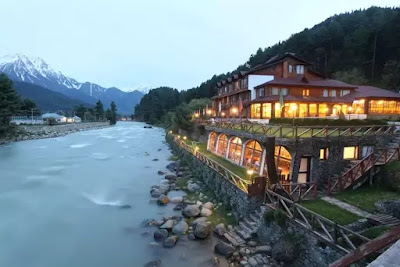 |
| Pahalgam |
Pahalgam is a town and an informed region board of trustees in Anantnag locale of the Indian condition of Jammu and Kashmir. It is a well known visitor goal and slope station. It is found 45 kilometers (28 mi) from Anantnag on the banks of Lidder River at a height of 7,200 feet (2,200 m). Pahalgam is the central command of one of the five tehsils of Anantnag area. Pahalgam is related with the yearly Amarnath Yatra. Chandanwari, found 16 kilometers (9.9 mi) from Pahalgam is the beginning stage of the yatra that happens each year in the times of July-August.
 |
| Doda |
Doda is a region in eastern piece of Jammu district of the Indian condition of Jammu and Kashmir. The area comprises of 8 pieces: Bhagwa, Assar, Doda, Gundana, Marmat, Bhaderwah, Gandoh (Bhalessa), and Thathri. The Doda region comprises of territories drawn from the old realms of Kishtwar and Bhadarwah, both of which were a piece of a region by the name of "Udhampur" in the royal condition of Jammu and Kashmir. In 1948, the recent Udhampur area was apportioned into the present Udhampur region, containing the Udhampur and Ramanagar tehsils, and a "Doda" region containing the Ramban, Bhadarwah and Kishtwar tehsils. In 2006, Ramban was made into a free region and the sloping zone toward the east of the present Doda area was isolated as the Kishtwar region. The rest of the ranges incorporate the Doda tehsil cut out of Kistwar and the first Bhadarwah, now isolated into three tehsils.
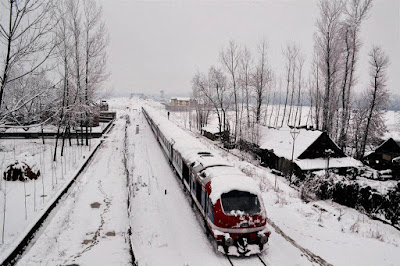 |
| Baramulla |
The name Baramulla is gotten from the Sanskrit Varahamula (वराहमूल), a blend of varaha (hog) and mul (root or profound) signifying "hog's molar." As indicated by Hindu lessons, the Kashmir Valley was before a lake known as Satisaras (Parvati's Lake in Sanskrit). Old Hindu writings relate that the lake was involved by the devil Jalodbhava (signifying "started from water") until Lord Vishnu expected the type of a hog and struck the mountain at Varahamula. This made an opening for the water to stream out of the lake. The present day Baramulla was called Varahamulaksetra or Varahaksetra in the old days. Initially, it was a suburb of Huviskapura (present day Ushkur). Related with the Adivaraha, the hog incarnation of Visnu, it was viewed as extremely sacrosanct. Thusly numerous sanctuaries and religious communities were inherent the ninth and tenth hundreds of years, amid the locale of Lalitaditya Muktapida, (Queen) Sugandha, and Ksemagupta, when the clique of Visnu prospered there.
 |
| Katra |
Katra or Katra Vaishno Devi, as it is famously known, is a residential community in Reasi region of the Indian condition of Jammu and Kashmir arranged in the foothills of the Trikuta Mountains, where the blessed sanctuary of Vaishno Devi is found. It is found 42 km from the city of Jammu. Katra fills in as the base camp for travelers who visit Vaishno Devi. It has a flourishing tourism industry that offers a lot of inns, visitor houses, eateries, dhabas, fast-food joints that fit a wide range of spending plans. Free convenience is given by some enrolled confides as Sarais for poor people. The quantity of explorers that visit the sanctum consistently has expanded from 1.4 million in 1986 to 8.2 million in 2009. Throughout the years, a great deal has changed, however one ought not miss the chance to stroll through the principle bazaar (advertise) for purchasing (bear in mind/delay to arrange a bit) trinkets, dryfruits, woolen pieces of clothing, hosiery, cowhide coats, etc.To reach Vaishno Devi Mandir(temple) the pioneers need to enroll at the Katra before beginning the trek. By enrolling, the pioneers get mischance protection while on the trek for 1 lakh INR. It is a trek of 14 km.There is another trek (1.5 km) from Vaishno Devi sanctuary for Baba Bhaironnath. It is said that the journey is not finished until you visit this sanctuary finally. The view all through the trek is picturesque.Environment-accommodating auto rickshaws and helicopter administrations are accessible, to make the adventure a lovely one.
 |
| Patnitop |
Patnitop or Patni Top is a ridge vacationer area in Udhampur region in Jammu and Kashmir condition of India on National Highway 44 112 km (70 mi) from Jammu in transit from Udhampur to Srinagar. Arranged on a level in the Shivalik belt of the Himalayas, Patnitop sits at a height of 2,024 m (6,640 ft). The waterway Chenab streams in nearness to this area. Snowfall and torrential slide in winter at Patnitop blocks National Highway 44 (prior name: National Highway 1A) a couple times each winter and causes long lines of vehicles - now and then for a considerable length of time finally. India's longest street burrow, the 9.2 km (6 mi) long Chenani-Nashri Tunnel or Patnitop Tunnel has been uncovered beginning from around 2 km (1 mi) from Chenani town south of Patnitop to Nashri town north of Patnitop to decrease the separation from Jammu to Srinagar and lessen car influxes on NH 44 that happen because of snowfall and torrential slide in winter at Patnitop. The Southern entrance (end) of the passage is at 33.0463°N 75.2793°E and the Northern entry (end) of the passage is at directions 33.1285°N 75.2928°E. At the point when the street passage is opened to movement by the center of 2017, the thruway will no longer go through Patnitop. The passage will decrease the length of the roadway by 31 km (19 mi) and the parkway will sidestep Patnitop. The removal of the passage has been finished and it is required to be opened for activity by center of 2017.
 |
| Hemis |
Hemis, likewise spelled Hamis, is a town in the Leh area of Jammu and Kashmir, India. It is situated in the Leh tehsil, 40 km southeast of the Leh town, in Ladakh. Hemis is outstanding for the Hemis religious community that was set up in 1672 AD by ruler Senge Nampar Gyalva. The town has a beautiful celebration held in July. It is near the Hemis National Park, a region that is home to the imperiled snow panther. The national stop was made in 1981. Hemis Monastery as of now existed before the eleventh century. Nāropā, the student of the yogi Tilopa, and instructor of the interpreter Marpa was associated with this cloister. An interpretation of Naropa's account has been found in Hemis cloister. It has been interpreted by A. Grünwedel (Nӑro und Tilo,: Festschrift Ernst Kuhn, München 1916). In 1887, Nicolas Notovitch composed a book guaranteeing to be the interpretation of an archive held in Hemis Library that states Jesus had spent his obscure years at the Hemis cloister.
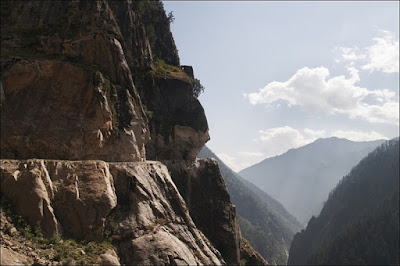 |
| Kishtwar |
Kishtwar is a region in the Kishtwar District of the Jammu area in J&K. As the seat of area organization, it houses administrative workplaces including the Deputy Commissioner, Additional Deputy Commissioner, Assistant Commissioner Revenue, Chief Medical Officer, Chief Education officer, Chief Horticulture Officer, Chief Agriculture officer, Sheep Husbandry, ChiefAnimal Husbandry officer, DFO, ACD, Executive Engineer (Xen) PWD, Xen PDD, Xen PHE, GM NHPC, GM CVPP and other locale officers. The town is the main region of the region and focus of business and learning in the area. The town has been the seat of the noteworthy kingdom of Kishtwar and has confronted numerous awesome Indian military crusades including that of Mughals. The ruler of Kishtwar was the auxiliary of Kashmir Kingdom and owe its social and semantic likeness to the Kashmir valley. The locals likewise talk an unmistakable dialect identified with this region just and has been named as Kishtwar. Being a piece of Dogra kingdom certain traditions and expressions of Dogri have additionally been fused in the local dialect.
Kishtwar is first alluded to in the Rajatarangini by the old name Kashthavata, amid the rule of Raja Kalsa of Kashmir (1063–1089), when "Uttamaraja", the leader of Kashthavata went by the court of the Kashmir King in organization with a few other slope boss to offer their regards to the Raja. The Mehta Family was given the grounds of Kishtwar by the King of Kashmir. Their family sanctuary "Hatta Wali Mata" and their legacy can at present be followed back to Kishtwar. The organizer of this family was the Commander-in-Chief of the Kashmir Army "Taste E-Salar Sri Jiya Lal Mehta". Known for his fortitude and valor he battled the Mughals and northern thieves who attacked the land.Kishtwar converged with the State of Jammu and Kashmir in 1821, A.D. With the progression of time Kishtwar turned into a Tehsil of District Udhampur and remained so until 1948, when it turned out to be a piece of the recently made District Doda in the wake of first re-association of the state amid the post-autonomy period.
 |
| Leh Ladakh |
 |
| Gulmarg |
Gulmarg is a town, a slope station, a well known skiing goal and an advised territory board in the Baramula region of the Indian condition of Jammu and Kashmir. The town is arranged in the Pirpanjal extend in the western Himalayas. Initially named Gaurimarg ("the reasonable one") by shepherds out of appreciation for the Hindu goddess Parvati, the resort was renamed Gulmarg ("knoll of blossoms") by Sultan Yusuf Shah of the Chak Dynasty who frequented the place with his ruler Habba khatoon in the sixteenth century. Wild blooms of 21 distinct assortments were gathered by the Mughal head Jahangir for his greenery enclosures in Gulmarg. In the nineteenth century, British government employees began utilizing Gulmarg as a withdraw to escape summers in North Indian fields. Chasing and hitting the fairway were their most loved side interest and three greens were built up in Gulmarg including one only for ladies. One of the fairways survives and at an elevation of 2,650 meters (8,690 ft) is the world's most astounding green. In 1927, British set up a ski club in Gulmarg and two yearly ski occasions were facilitated one each amid Christmas and Easter. Focal Asian pilgrim Aurel Stein additionally went by Gulmarg amid this period.
GORGEOUS GARDENS
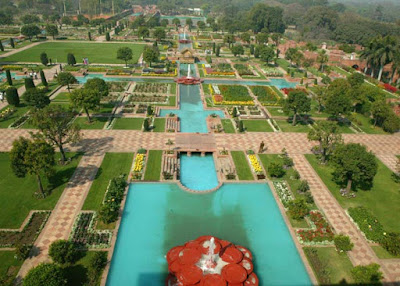 |
| The Mughal Garden |
The organizer of the Mughal realm, Babur, portrayed his most loved kind of garden as a charbagh. They utilize the term bāgh, baug, bageecha or bagicha for garden. This word built up another significance in India, as Babur clarifies; India did not have the quick streaming streams required for the Central Asian charbagh. The Agra plant, now known as the Ram Bagh, is thought to have been the primary charbagh. India, Bangladesh and Pakistan have various Mughal gardens which contrast from their Central Asian ancestors regarding "the exceptionally restrained geometry". An early printed references about Mughal greenery enclosures are found in the journals and life stories of the Mughal rulers, including those of Babur, Humayun and Akbar. Later references are found from "the records of India" composed by different European explorers (Bernier for instance). The main genuine authentic investigation of Mughal patio nurseries was composed by Constance Villiers-Stuart, with the title Gardens of the Great Mughals (1913). Her better half was a Colonel in Britain's Indian armed force. This gave her a decent system of contacts and a chance to travel. Amid their living arrangement at Pinjore Gardens, Mrs. Villiers-Stuart likewise had a chance to coordinate the support of a vital Mughal plant. Her book makes reference to the pending outline of a garden in the Government House at New Delhi (now known as Rashtrapati Bhavan). She was counseled by Edwin Lutyens, and this may have affected his decision of Mughal style for this venture. Late insightful work on the historical backdrop of Mughal greenery enclosures has been done under the promising direction of Dumbarton Oaks (counting Mughal Gardens: Sources, Places, Representations, and Prospects altered by James L. Wescoat, Jr. also, Joachim Wolschke-Bulmahn) and the Smithsonian Institution. A few cases of Mughal patio nurseries are Shalimar Gardens (Lahore), Lalbagh Fort at Dhaka, and Shalimar Bagh (Srinagar).
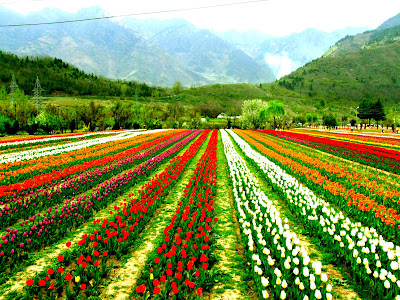 |
| Indra Gandhi Memorial Tulip Garden |
Indira Gandhi Memorial Tulip plant, already Model Floriculture Center, is a tulip plant in Srinagar, India. It is the biggest tulip plant in Asia spread over a territory of around 30 hectares. It is arranged on the foothills of Zabarwan Range with a review of Dal Lake. The garden was opened in 2007 with the intend to lift horticulture and tourism in Kashmir Valley. The garden is based on a slanting ground in a terraced design comprising of seven patios. Aside from tulips, numerous different types of blooms - hyacinths, daffodils and ranunculus have been included too. Tulip celebration is a yearly festival that expects to exhibit the scope of blooms in the garden as a piece of tourism endeavors by the Government of Jammu and Kashmir. It is composed amid the onset of spring season in Kashmir valley. In 2017, the Tulip Festival is being sorted out for 15 days from April 1 to April 15.
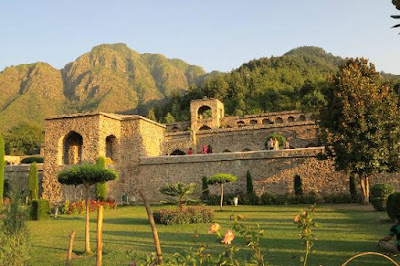 |
| Pari Mahal |
Pari Mahal or The Angels' Abode is a seven terraced cultivate situated at the highest point of Zabarwan mountain run over-looking city of Srinagar and south-west of Dal Lake. The design portrays a case of Islamic engineering and support of craftsmanship amid the rule of the then Mughal Emperor Shah Jahan. It is five-minute drive from Cheshmashahi, Srinagar. The Pari Mahal was worked by Mughal Prince Dara Shikoh in the mid-1600s. It filled in as a library and a homestead him. Dara Shikoh was said to have lived around there in the years 1640, 1645, and 1654. It was additionally utilized as an observatory, helpful for showing soothsaying and cosmology. The greenhouses have since turned into the property of the Srinagar government.
SPECTACULLAR VALLEYS
 |
| Pangong Tso |
Pangong Tso is in questioned region. The Line of Actual Control goes through the lake. A segment of the lake around 20 km east from the Line of Actual Control is controlled by China yet asserted by India. The eastern end of the lake is in Tibet. After the mid-nineteenth century, Pangong Tso was at the southern end of Johnson Line, an early endeavor at outline amongst India and China in the Aksai Chin area. The Khurnak Fort lies on the northern bank of the lake, most of the way of Pangong Tso. The Chinese has controlled the Khurnak Fort range since 1952. To the south is the littler Spanggur Tso lake. On October 20, 1962, Pangong Tso saw military activity amid the Sino-Indian War, effective for the Communist People's Liberation Army. Pangong Tso is as yet a fragile fringe point along the Line of Actual Control. Incursions from the Chinese side are normal.
 |
| Zanskar |
Zanskar or Zangskar is a subdistrict or tehsil of the Kargil region, which lies in the eastern portion of the Indian condition of Jammu and Kashmir. The managerial focus is Padum. Zanskar, together with the neighboring district of Ladakh, was quickly a piece of the kingdom of Guge in Western Tibet. The Zanskar Range is a mountain go in the Indian condition of Jammu and Kashmir that isolates Zanskar from Ladakh. Geographically, the Zanskar Range is a piece of the Tethys Himalaya, a roughly 100 extensive synclinorium shaped by emphatically collapsed and imbricated, feebly transformed sedimentary arrangement. The normal tallness of the Zanskar Range is around 6,000 m (19,700 ft). Its eastern part is known as Rupshu. It additionally isolates Kinnaur District from Spiti in Himachal Pradesh. The most noteworthy pinnacles of Himachal are in the Zanskar Range. Zanskar shows up as "Zangskar" generally in scholarly reviews in sociologies (humanities, sexual orientation thinks about), mirroring the Ladakhi elocution, in spite of the fact that the Zanskari articulation is Zãhar. More established geological records and maps may utilize the substitute spelling "Zaskar". An etymological review (Snellgrove and Skorupsky, 1980) of the name uncovers that its starting point may allude to the normal event of copper in this district, the Tibetan word for which is "Zangs". The second syllable however is by all accounts all the more difficult as it has different implications: "Zangs-dkar" (white copper), "Zangs-mkhar" (copper castle), or "Zangs-skar" (copper star). Others guarantee it gets from zan = copper + skar = valley. Crook (1994) somewhat shares this elucidation yet proposes that the birthplace of this name may likewise be "Zan-mKhar" (sustenance castle), on the grounds that the staple nourishment products are so copious in a generally rather dry locale. The privately acknowledged spelling of the name in Tibetan script is zangs-dkar.
 |
| Nubra Valley |
Nubra is a tri-equipped valley situated toward the north east of Ladakh valley. Diskit the capital of Nubra is around 150 km north from Leh town, the capital of Ladakh region, India. Neighborhood researchers say that its unique name was Ldumra (the valley of blooms). The Shyok River meets the Nubra or Siachan River to shape a huge valley that isolates the Ladakh and Karakoram Ranges. The Shyok waterway is a tributary of the Indus stream. The normal height of the valley is around 10,000 ft. i.e. 3048 meters over the ocean level. The normal approach to get to this valley is to go over the Khardung La go from Leh town. Outside nationals are required to get a Protected range allow to visit the Nubra Valley. Since 1 May 2014 Indian nationals are no longer required to get an Inner Line Permit to visit the valley. Like whatever remains of the Tibetan Plateau, Nubra is a high height frosty abandon with uncommon precipitation and sparse vegetation aside from along waterway beds. The towns are inundated and prolific, delivering wheat, grain, peas, mustard and an assortment of foods grown from the ground, including blood apples, walnuts, apricots and even a couple almond trees. The majority of the Nubra Valley is possessed by Nubra lingo or Nubra Skat speakers. The larger part are Buddhists. In the western or most minimal elevation end of Nubra Valley close to the Line of Control i.e. the Indo-Pak fringe, along the Shyok River, the tenants are Balti of Gilgit-Baltistan, who speak Balti, and are Shia and Sufia Nurbakhshia Muslims.
 |
| Drass Valley |
Dras is a town in the Kargil District of Jammu and Kashmir, India. It is frequently called 'The Gateway to Ladakh'. It is at a stature of 3230 m or 10990 ft. The mountain edges however run from 16000 feet to 21000 feet. The Dras valley begins from the base of the Zojila pass, the Himalayan passage to Ladakh. For a considerable length of time, its occupants have been known to have arranged this imposing pass notwithstanding amid the most dangerous period (in late harvest time or early spring, when the entire area remains snow-bound and is liable to successive snow tempests) to transport exchanging stock and to help stranded explorers navigate the pass. They in this way settled a restraining infrastructure over porterage amid the prime of the dish Asian exchange. A strong people continuing with courage the brutality of the valley's winter, the occupants of Dras can well be depicted as the gatekeepers of Ladakh's entryway.
 |
| Betab Valley |
Betaab valley is arranged at a separation of 15 kilometers from Pahalgam in Anantnag locale in India's northernmost condition of Jammu and Kashmir. The valley got its name from the Sunny Deol-Amrita Singh hit make a big appearance film Betaab. The Valley is towards upper east of Pahalgam and falls amongst Pahalgam and Chandanwadi and is on the way Amarnath Temple Yatra. The valley encompassed by rich green glades, snow clad mountains and secured with thick vegetation. Betaab Valley, which is a piece of Pahalgam zone – one of the few Sub-valleys of Kashmir Valley appeared amid the post geosynclinal phase of the improvement of the Himalayas. Betaab Valley lies between the two Himalayan Ranges – Pir Panjal and Zanskar. Archeological proof demonstrates the human presence in this area from the Neolithic Age, particularly at Burzahom, Bomai and Pahalgam. Betaab Valley – a piece of the Kashmir locale, was governed by the Mughals since the fifteenth Century. In last some portion of the fifteenth century the Turko-Mughal Military General Mirza Muhammad Haidar Dughlat led over Kashmir first for the benefit of Sultan Said Khan of Kashgar and after that in the interest of the Mughal Emperor Humayun. A multilingual and a recorded essayist, General Haider composed the 'Tarik-i-Rashidi' – an individual diary of the Central Asian History. Sultan Ghiyas-ud-Din Zain-ul-Abidin known by every one of his subjects and Nobles as the best neighborhood King ruled the whole Kashmir locale for around 40 years amid which he was renowned for advancing peace and congruity in Kashmir's pluralistic culture. He even gave an order to reestablish and rebuild Kashmir amid his rule – very in spite of traditional outside attacking rulers. It was under him that "Kashmiriyat" – a 'social and social awareness' of Kashmiri individuals was created.
 |
| Baltal Valley |
Baltal is an outdoors ground for explorers, 15 km north of Sonamarg on the Sind River at the base of Zojila go in Jammu and Kashmir (India). This little valley is just a day's adventure far from and gives a shorter high-height backup way to go to the consecrated give in of Amarnath. Roosted at a rise of 2,743m, the good country pastures, Baltal fills in as the construct camp for explorers in light of their ahead voyage to Amarnath Caves, 14 km away. The site is seen with pitched tents implied for the travelers to spend the night. Baltal is one hour from Sonmarg on a taxi or a transport. It can likewise be come to from Pahalgam, 24 km away, in around 45 minutes. For climbers, it takes around 5 hours to achieve Baltal from Pahalgam. Famous for its beautiful excellence, Baltal glades offers tent settlement for the travelers and vacationers alike at sensible costs. Both horse rides or, for the individuals who can bear, helicopter administrations are accessible to the blessed Amarnath Caves. Helicopter travelers need to land at Panjtarni and foot it, or take a horse ride, to the surrender, 5 km away. For the climbers, the 14 km separate from Baltal to Amarnath takes around 4 hours on a winding steep trail. Fundamental teashops are accessible on course.
 |
| Warwan Valley |
From Nowapachi onwards, the wedding way towards Warwan rises through thick woodland, thick estate and luhgreen pastures. Horse riding is appreciated by numerous on this way as its plain and appropriate for such ride. In the wake of voyaging a separation of around 24 kms we achieve Dassbal, a town better called 'The Gate method for warwan Valley', at a height of more than 7000ft from ocean level. The town is possessed with Shia Muslims who have moved to this place from Zanskar region of Kargil region. They have their own particular traditions and conventions, very as opposed to the lion's share Sunni Muslims of Warwan valley. 6 kms. in front of Dassbal is Inshan, the headquarter of Warwan piece. About the verdent and the grinning valley of Warwan words falls flat me to portray its natrual excellence. Infact Warwan valley outperforms all other wonderful spots situated in this visitors circuit. The 15-20 kms extend of Warwan valley from Inshan to Sukhnai is plain with rich green glades on either side of the stream 'Mariv Sudir', which winds through the valley in a crisscross way, shaping lovely regular parks where visitors can pitch their tents amid summer months and make the most of their stay in the tranquil, cool, mitigating and contamination free climate.
Mariv sudir at warwan is known for creating a high caliber of Trout's. Angling as an exchange can be empowered here for the financial advantage of the general population. Towns Inshan, Branyan, Mul-warwan, Basmina, Margi, Gumri and Sukhnai are the primary towns of warwan square. The wood-material of the ouses takes after that of Kashmir valley towns. This is done in an approach to safe-protect the houses from the ideas of unpleasant climate and overwhelming snowfall amid winter. As warwan valley has an atitude of more than 8000 ft from ocean level, so the place is colder than Marwah and estate is rare and high elevation crops like 'horrid', "codra" and so on are developed. Potatoes are in bounty and extremely delectable. As the range contains various high elevation peaks pastures so a huge number of bakkerwal families relocate from fields of Jammu and furthermore from Kashmir valley to tend their groups of sheep and goats and crowds of dairy cattle. There is, along these lines, an extraordinary buzzing about in warwan amid summer. Horse riding is the best side interest here. High breed steeds are accessible here.
NATIONAL PARKS
 |
| Dachigam National Park |
Dachigam National Park is found 22 kilometers from Srinagar, Jammu and Kashmir. It covers a territory of 141 km. The name of the recreation center actually remains for "ten towns" which could be in memory of the ten towns that were moved for its formation. The recreation center has been an ensured range since 1910, first under the care of the Maharaja of Jammu and Kashmir and later under the perception of the concerned government experts. It was at first made to guarantee clean drinking water supply for the city of Srinagar. It was at long last updated and proclaimed a National Park in the year 1981. Dachigam National stop is situated in the Zabarwan Range of the western Himalayas. The variety in elevation is endless, extending from 5500 ft to 14000 ft above mean ocean level. Because of this endless variety, the recreation center is extremely flawed n beekaar differentiated into an uneven locale. The territory ranges from tenderly inclining fields to sharp rough outcrops and bluffs. Some portion of the recreation center claim sort of regular excellence with uncovered shake mountains and cleft.
No comments:
Post a Comment